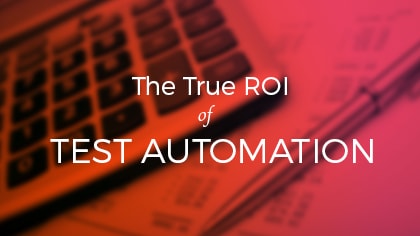Creating a robust UI Testing Framework is critical to building quality software. In this article, we delve into the nuances of developing an effective test automation framework, guiding you through the intricate landscape of UI testing.


As businesses increasingly rely on software applications, the need for reliable and efficient UI testing frameworks has never been more critical. Join us to explore the various facets of building a test automation framework, emphasizing the importance of precision, adaptability, and efficiency, and offering a structured approach to the topic.
The significance of UI testing frameworks in enhancing the efficiency and accuracy of creating quality software is immense.
A UI testing framework is a set of guidelines and tools designed to test the user interface of applications. It aims to ensure that the application behaves as expected from the user’s perspective. The framework includes components like test scripts, libraries, and tools that work together to automate the testing process.
Don’t miss our case studies to see how our work makes a difference in real-world scenarios!
Introduction to UI Test Automation Frameworks


A UI testing framework provides the foundation for designing and executing automated tests for web applications, mobile apps, and other software interfaces. It includes a comprehensive environment for test creation, execution, and analysis, supporting various programming languages and testing tools.
UI testing, a critical component of software quality assurance, involves the validation of graphical user interfaces to ensure they meet specified requirements. Test automation frameworks are a set of guidelines or rules used to write tests and run them. These frameworks enable automated testing of the UI, making the process more efficient and less prone to human error.
Types of Automated Testing Frameworks
There are several types of test automation frameworks, each with its own architecture, methodology, and tools. These include data-driven, keyword-driven, and hybrid frameworks.
Data-Driven Frameworks
These frameworks focus on separating the test script logic from the test data. They allow you to create test scripts that can be used repeatedly with different data sets. This approach is beneficial when you need to run the same test scenario with multiple sets of data.
Keyword-Driven Frameworks
In contrast, keyword-driven frameworksseparate the test script logic and the test instructions. These instructions, or “keywords,” are independent of the framework and can be grouped to form a test script.
Hybrid Frameworks
Offering a blend of the best features from both data-driven and keyword-driven frameworks, hybrid frameworks cater to a broad spectrum of testing needs. They excel in providing flexibility and scalability, making them a popular choice for various test automation projects.
Each type of test automation framework has its own advantages and disadvantages, and the choice depends on the specific needs of the project.
For instance, a data-driven framework might be a good choice if you need to run the same test scenario with different sets of data, while a keyword-driven framework might be more suitable if you want to separate the test script logic from the test instructions.
Core Components of Test Automation Frameworks


A UI automated testing framework comprises several key components. These include the test data preparation, test execution, and result reporting. Each component plays a vital role in ensuring the effectiveness of the framework.
- Test data preparation involves creating, managing, and maintaining all the data needed for the tests. This could include user data, product data, or any other data that the tests might require. The test data should be realistic, comprehensive, and up-to-date to ensure the accuracy of the test results.
- Test execution is the process of running the tests. This involves executing the test scripts, monitoring the test execution, and managing any errors or issues that might arise during the test execution.
- Result reportinginvolves collecting, analyzing, and reporting the results of the test execution. This includes identifying and reporting any defects, analyzing the test coverage, and providing feedback on the quality of the software application.
Each component plays a vital role in ensuring the effectiveness of the UI testing framework. They work together to provide a comprehensive, efficient, and effective testing process.
In this article, we explain how we make our test progress visible on every project.
Building an UI Test Automation Framework from Scratch


Building an UI test automation framework from scratch involves several steps. It starts with understanding the application’s requirements, followed by selecting the appropriate tools and technologies. The next steps include designing the framework’s structure, implementing the tests, and integrating the framework into the software development lifecycle.
1. Understanding the Requirements
Acknowledging the application’s requirements is the first and most crucial step. This involves understanding the functionality of the application, the user interactions, and the expected outcomes. It also involves understanding the technical architecture of the application, including the programming languages used, the database structure, and the API endpoints.
2. Selecting Tools
Once you have a good understanding of the application’s requirements, the next step is to select the appropriate tools and technologies for your framework. There are numerous automated testing tools and technologies available in the market, each with its own features, capabilities, and limitations to cater to different testing needs.
Choosing the right automated UI testing tools is pivotal for achieving efficient and effective test automation.
Some Factors to Consider:
- Compatibility with the application’s technology.
- Ease of scripting and test maintenance.
- Support for various testing types like cross-browser testing and API testing. Learn more about this in our End-to-end API testing guide.
On the whole, you may base your choice on the specific needs and requirements of the application, the skills and expertise of the testers, and the budget and resources available.
3. Framework Designing
Designing the framework’s structure is the next step in building an UI test automation framework. This implies defining the framework architecture, including the test script organization, the test data management, and the test results reporting.
While designing, always remember that the framework’s structure should be scalable, maintainable, and easy to use.
Check out this episode of the Quality Sense Podcast from automated testing at scale, with Federico Toledo and Andy Knight.
4. Testing
Implementing tests is the next step in building a UI test automation framework. This involves writing the test scripts, creating the test data, and setting up the test environment.
Once you have a collection of test scripts, you group them into a test suite. This suite comprises test cases designed to assess specific functionalities of a software program, thereby enhancing testing coverage and enabling both accuracy and effective testing.
The next crucial step is to run tests, which entails executing the test suite, monitoring the process, and analyzing the results.
Writing Effective Test Scripts
Test scripts are the backbone of any testing framework. They should be clear, maintainable, and reusable.
Tips for Writing Test Scripts
- Use descriptive names for test cases.
- Keep scripts short and focused on a single functionality.
- Implement modular scripting to enhance reusability.
Managing Test Data Efficiently
Proper management of test data is crucial for accurate and effective testing.
Best Practices:
- Use data-driven approaches for scalability.
- Ensure data is relevant and updated.
- Implement mechanisms for data privacy and security.
Automating Complex Test Scenarios
Automating complex tests requires a strategic approach and advanced scripting capabilities.
- Break down complex tests into smaller, manageable components.
- Employ advanced techniques like behavior-driven development (BDD) for clarity.
- Use tools that support complex test automation like Selenium.
- Maintain and update the test automation framework to keep the framework effective and relevant.
Learn more about the benefits of automated functional testing in this article!
Enhancing Test Coverage and Accuracy and Effective Testing
Coverage measures the extent to which the software is tested. High coverage and accuracy are essential for a reliable UI testing framework.
Some main steps:
- Besides UI tests, employ different types of tests like unit tests and integration tests.
- Implement automated tests for common scenarios across environments.
- Use coverage tools to identify untested parts of the application.
- Use tools that support multiple browsers and platforms.
- Regularly review and update test cases to cover new features and changes.
Watch this webinar about How to Use Automation to Increase Test Coverage!
5. Integrating the Framework into The Software Development Lifecycle
This is the final step in building a UI test automation framework. It involves integrating the framework with the development, testing, and deployment processes. Such integration allows for continuous testing, early detection of issues, and faster feedback.
Effective integration of automated testing within the development cycle enhances efficiency and enables continuous testing.
Some integration Strategies
- Implementing continuous integration (CI) pipelines.
- Aligning automated testing with Agile methodologies.
- Ensuring seamless collaboration between developers and testers.
Interested in learning how to automate a Web UI testing framework? Find out in this article.
Training and Skill Development


Continuous learning and skill enhancement are vital for test automation engineers to keep up with evolving technologies.
Skill Development Areas
- Mastery of relevant programming languages and testing tools.
- Understanding of the latest trends in test automation and software development.
- Development of analytical and problem-solving skills.
At Abstracta, we excel at taking care of our continuous learning. We invest in training and always stay at the forefront of new technologies. We love to experiment, share our knowledge, and build enduring allies.
Read this article to acknowledge why Abstracta’s testers can elevate your software quality
Incorporating AI and Machine Learning in UI Testing
Artificial Intelligence (AI) and Machine Learning (ML) can significantly enhance the testing capabilities of a UI testing framework. Some applications of AI/ML in testing include:
- Automated test case generation and optimization.
- Predictive analysis to identify potential problem areas.
- Enhanced test accuracy and efficiency through intelligent algorithms.
The Future of Test Automation Frameworks
The future of test automation frameworks lies in their ability to adapt to emerging technologies and methodologies. Some future trends include:
- Increased integration of AI and ML in testing.
- Greater emphasis on security testing within the framework.
- Evolution towards more user-centric testing approaches.
In a Nutshell


Building an effective UI testing framework is an ongoing process that requires dedication, innovation, and adaptability.
By understanding the core components, choosing the right tools, and continuously evolving with technological advancements, organizations can create robust and efficient frameworks that stand the test of time.
The journey towards a flawless user interface is both challenging and rewarding, making the role of automated testing frameworks indispensable in the world of creating quality software.
Would you like to know more about automated testing? Don’t miss our Complete Guide to Automated Functional Testing!
Looking for a Quality Partner to help you build or improve your UI testing strategy? Contact us to discuss how we can help you grow your business.


Tags In


Abstracta Team
Related Posts
The True ROI of Test Automation
Is test automation just a huge expense or an investment? Is there a positive ROI of test automation? Generally, it’s said that automated testing can extend the coverage and scope of testing, reduce costs, mitigate risk, put the focus on manual testing where it’s really necessary, find…
Quality Sense Podcast: Vaishali Padghan – Test Automation
Welcome to the second to last episode of this season of the Quality Sense podcast! We’re getting closer to the end of this cycle with an interview with Vaishali Padghan, she is responsible for different quality initiatives, trying to deliver quality products faster at J.P.Morgan…
Search
Contents








